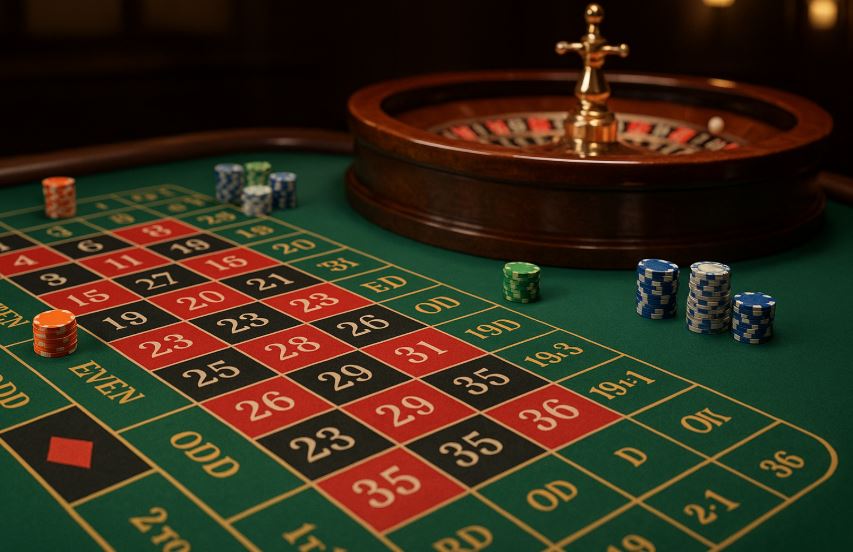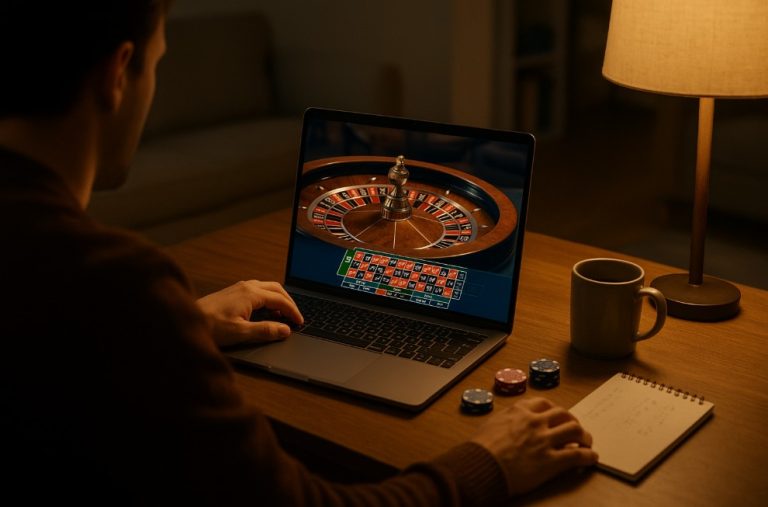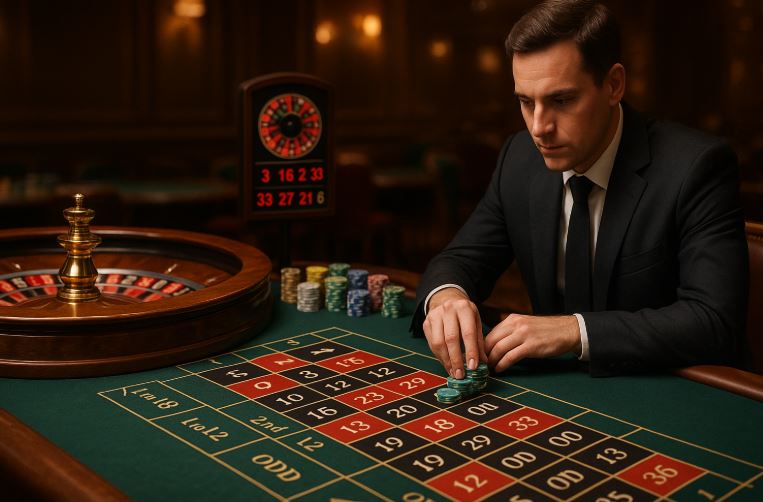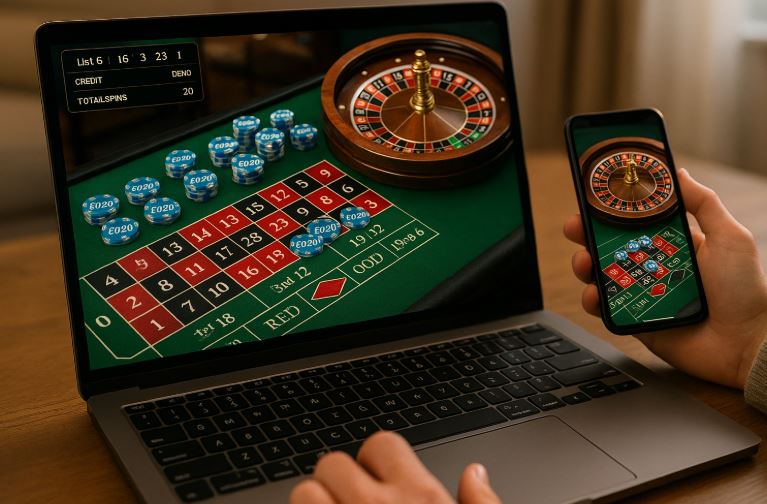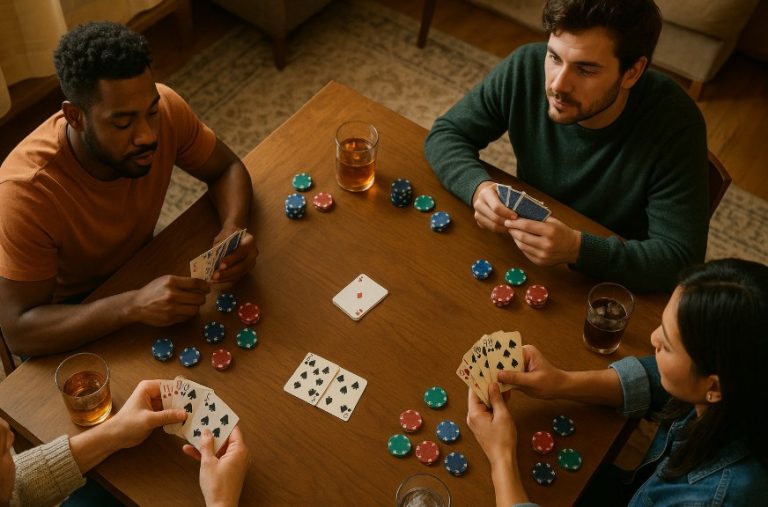Roulette Table Layout Explained | A Complete Beginner’s Guide
Walking into a casino for the first time, one might find their eyes drawn immediately to the elegant spin of the roulette wheel. The anticipation, the colours, the sound of the ball slowing down, it’s captivating. But then, there’s the table itself.
Rows of numbers, columns of coloured boxes, different sections with names like “1st 12” or “Odd” or “Voisins du Zero”. For a beginner, it can feel overwhelming.
Understanding the roulette table layout is crucial for any player hoping to enjoy this game intelligently. This guide aims to strip away the confusion and help new players gain confidence at the table.
Whether you’re preparing to play online or at a land-based UK casino, knowing the layout and how it works is your first step toward smarter roulette play. Let’s dive in.
What Should Beginners Know About the Roulette Table Layout?

The roulette table layout is the visual and physical representation of betting options in the game of roulette. It’s where players place their chips to bet on numbers, colours, and combinations.
The layout consists of numbers from 1 to 36, with one or two zeros depending on the version of roulette. The numbers are organised in a grid format, divided into three columns and 12 rows. These are known as the inside bets area. Surrounding this central grid are other sections for outside bets like odd/even, red/black, high/low, and dozens.
The table layout is colour-coded. Red and black alternate for the numbers 1 through 36, while green is reserved for zero or double zero. This makes it easier for players to spot betting trends or follow strategies based on colour or type.
Understanding this setup helps players make more informed decisions, particularly when trying out different betting strategies. Whether placing a straight-up bet on one number or a column bet covering 12 numbers, knowing where to put your chips and how each section functions is key.
Roulette may appear to be a game of luck, and to an extent, it is, but a strong understanding of the layout gives players a strategic edge. It allows them to explore betting combinations and manage their risks better.
How Is the Roulette Wheel Structured and What Do the Numbers Mean?
The roulette wheel is the heart of the game. It’s where outcomes are determined, and understanding how it’s structured will deepen your comprehension of the table layout.
The wheel features a series of numbered pockets, ranging from 0 to 36 in European roulette and 00 to 36 in American roulette.
The pockets alternate between red and black, with 0 or 00 being green. These numbers aren’t arranged sequentially but are placed in a specific order that creates balance across the wheel.
Here’s a breakdown of the structure:
European Wheel (Single Zero)
- Total pockets: 37 (numbers 0 to 36)
- Colour breakdown: 18 red, 18 black, 1 green (0)
- The numbers are spaced so that high and low, odd and even, and red and black alternate as much as possible
American Wheel (Double Zero)
- Total pockets: 38 (numbers 0, 00, and 1 to 36)
- Colour breakdown: 18 red, 18 black, 2 green (0 and 00)
The order of numbers around the wheel might appear random, but it’s carefully designed to create balance. In a European wheel, the numbers are arranged in a way that alternates high/low and odd/even as much as possible, keeping the game fair and unpredictable.
For example, here’s the clockwise sequence of a single-zero wheel:
0-32-15-19-4-21-2-25-17-34-6-27-13-36-11-30-8-23-10-5-24-16-33-1-20-14-31-9-22-18-29-7-28-12-35-3-26
The green zero pocket is always opposite a high-value number to help maintain randomness. The balance in this design ensures no part of the wheel is more likely to hit than others.
What Are the Different Types of Roulette and How Do They Affect Gameplay?
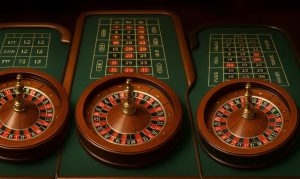
Roulette exists in several variations, each with subtle differences in rules, layout, and house edge. Understanding these versions helps players choose the one that aligns with their goals, whether that’s longer gameplay, better odds, or a different table structure.
European Roulette
- Features a single green zero (0)
- Total of 37 pockets
- Offers the best odds among the standard versions
- House edge: approximately 2.7%
- Most popular format in UK and European casinos
American Roulette
- Features both a single zero (0) and double zero (00)
- Total of 38 pockets
- House edge: approximately 5.26%
- Offers fewer chances to win due to the extra zero
- More common in North America
French Roulette
- Similar layout to European version (single 0)
- Includes additional rules like La Partage and En Prison
- These rules offer players back part of their stake if the ball lands on 0, lowering the house edge
- House edge for outside bets: approximately 1.35%
Other Versions
- Multi-ball Roulette: Uses more than one ball in play at once, increasing potential payouts
- Mini Roulette: Features only 13 numbers, offering quicker gameplay
- Live Dealer Roulette: Found online, mimicking real-life casino action through a live video stream
Each type has the same core gameplay, but these differences can significantly affect strategy and payout potential.
Roulette Table Layout Explained: How Do Inside and Outside Bets Work?
One of the first things to understand about the roulette table layout is the distinction between inside and outside bets. These categories determine the positioning of your chips, the odds of winning, and the payout rate.
Inside Bets
These are placed within the numbered grid.
Types of Inside Bets
| Bet Type | Numbers Covered | Payout |
| Straight Up | 1 number | 35 to 1 |
| Split | 2 adjacent numbers | 17 to 1 |
| Street | 3 numbers in a row | 11 to 1 |
| Corner (Square) | 4 numbers forming a square | 8 to 1 |
| Basket | 0, 1, 2, 3 (American only) | 6 to 1 |
| Six Line | 2 adjacent rows | 5 to 1 |
Outside Bets
Placed outside the number grid and cover larger groups of numbers.
Common Outside Bets
- Red or Black
- Odd or Even
- 1 to 18 or 19 to 36 (Low/High)
- Columns (12 numbers)
- Dozens (1st 12, 2nd 12, 3rd 12)
Payouts for outside bets are either 1 to 1 (even money) or 2 to 1 depending on the type.
Inside bets offer higher payouts but lower chances of winning, while outside bets are safer but with smaller returns.
What Role Does the Ball Play in Determining Roulette Outcomes?

The roulette ball is a tiny, weighted object that moves in the opposite direction of the spinning wheel. Its movement is crucial to determining the outcome of each round. When the ball finally loses momentum, it falls into one of the numbered pockets, ending the betting round.
How It Works?
- The croupier spins the wheel in one direction.
- The ball is released in the opposite direction along the outer rim.
- As the wheel slows, the ball bounces across the metal deflectors before settling into a pocket.
This process introduces a random, physical element to the game that cannot be influenced by players. Unlike slots or card games, roulette outcomes are visual and engaging, which adds to its popularity.
While some players believe in predicting outcomes by watching the ball’s behaviour, this has never been proven effective over time. The design of the wheel and ball movement ensures a random result each spin.
How Do Bet Placements Work and What Are the Payout Ratios?
Roulette betting begins before the wheel is spun. Players place chips on specific areas of the table that represent different betting choices. These areas are clearly marked, and understanding how they work is essential.
How to Place a Bet?
- Players use colour-coded chips to distinguish between different players at the same table.
- Bets are placed directly on the numbered grid (inside bets) or around the grid in designated sections (outside bets).
- The dealer announces when no more bets can be placed.
Bet Placement Layout
Inside Grid Layout
- Composed of 36 numbered squares plus one (or two) zero spaces.
- Bets placed here require precision and offer higher payouts.
Outside Bet Sections
Located around the main number grid.
These are labelled as:
- Red
- Black
- Odd
- Even
- 1st 12, 2nd 12, 3rd 12
- 1–18, 19–36
Payout Table Overview
| Bet Type | Numbers Covered | Payout |
| Straight Up | 1 | 35 to 1 |
| Split | 2 | 17 to 1 |
| Street | 3 | 11 to 1 |
| Corner | 4 | 8 to 1 |
| Six Line | 6 | 5 to 1 |
| Column | 12 | 2 to 1 |
| Dozen | 12 | 2 to 1 |
| Red/Black | 18 | 1 to 1 |
| Odd/Even | 18 | 1 to 1 |
| Low (1–18) / High (19–36) | 18 | 1 to 1 |
Betting placement is more than choosing a number; it’s about selecting a strategy that aligns with your risk level. Experienced players may mix inside and outside bets to diversify their risks across a single spin.
What Special Bets Exist in French and European Roulette Games?

French and European roulette games offer additional bet types based on sections of the wheel rather than the table layout. These are “called bets” or “announced bets” and are typically placed by more experienced players.
Voisins du Zero (Neighbours of Zero)
- Covers 17 numbers near zero on the wheel
- Includes a mix of split, corner, and trio bets
- Requires multiple chips to execute correctly
Tiers du Cylindre (Third of the Wheel)
- Covers 12 numbers opposite zero on the wheel
- Made using six split bets
Orphelins (Orphans)
- Covers 8 numbers not included in Voisins or Tiers
- Composed of straight and split bets
These bets are popular at European and French roulette tables and are especially common in land-based casinos where players may announce their bets verbally.
Although these bets offer lower payouts compared to straight-up bets, they provide wider coverage across the wheel and can be a useful part of broader roulette strategies.
What Are the Most Popular Roulette Betting Strategies?
While roulette is ultimately a game of chance, many players turn to betting systems to manage risk and structure their play. Here are some of the most popular methods:
Martingale System
- Double your bet after every loss
- A win recovers all previous losses plus a profit
- Risky, as a long losing streak can exhaust your bankroll quickly
Reverse Martingale (Paroli)
- Increase your bet after every win
- Limits losses during bad streaks
- Effective for short-term winning streaks
D’Alembert Strategy
- Increase bet by one unit after a loss
- Decrease bet by one unit after a win
- Less aggressive than Martingale
Fibonacci System
- Uses the Fibonacci sequence to structure bets
- Slower loss recovery but lower risk than Martingale
Flat Betting
- Bet the same amount every round
- Best for managing long-term bankroll
Each of these strategies has advantages and weaknesses. The most important thing is understanding that no system guarantees a win, and all play should be done responsibly.
How Can You Read and Understand a Roulette Table in a Real or Online Casino?

Reading a roulette table involves more than recognising numbers. It’s about understanding how different sections of the layout correspond to betting options.
Standard Layout Design
- Inside bets are placed on individual numbers or small groups
- Outside bets are placed on large sections like colours or odds
- The 0 or 00 is placed at the top of the grid
Table Labels
- “1st 12” covers numbers 1–12
- “2nd 12” covers 13–24
- “3rd 12” covers 25–36
- “1 to 18” and “19 to 36” cover low and high numbers respectively
Online versions of roulette replicate this layout exactly but may include interactive features such as chip value selectors and live bet tracking.
Live dealer versions allow players to see a real table streamed from a studio or casino, and place bets via a digital interface. These games preserve the classic layout while offering a digital twist for convenience.
Conclusion
Understanding the roulette table layout is essential for making smarter betting decisions. Whether you’re choosing between a straight-up number or a dozen bet, the layout tells you everything you need to know about your odds and potential payouts.
From the structure of the wheel to the house edge of each game variation, from special French bets to popular strategies, roulette is far more than a game of luck.
It’s a dynamic and exciting blend of chance and strategy, with the table layout serving as your roadmap.
The next time you sit down at a roulette table, whether online or in a land-based casino, you’ll be equipped with the knowledge to approach each spin with confidence. Enjoy the experience, play responsibly, and most importantly, have fun.
FAQs
What is the difference between inside and outside bets?
Inside bets are placed on specific numbers or small groups within the grid, offering higher payouts. Outside bets cover larger areas like red/black or odd/even and have better odds of winning but lower payouts.
Why does American roulette have a higher house edge?
American roulette includes a double zero (00) pocket, increasing the total number of outcomes to 38. This extra number raises the house edge to 5.26 percent.
What are the La Partage and En Prison rules in French roulette?
These rules apply when the ball lands on zero during an even-money outside bet. La Partage returns half your stake, while En Prison holds your bet for the next spin, giving you a chance to recover it.
Is it better to play European or French roulette?
French roulette offers the lowest house edge, especially with La Partage and En Prison rules. European roulette also has a lower house edge than American, making both preferable for players.
How many numbers are on a roulette wheel?
A European and French wheel has 37 numbers, including the single zero. An American wheel has 38 numbers, with the addition of a double zero.
Are the numbers on the roulette wheel arranged in order?
No, the numbers are arranged in a specific sequence to maximise randomness and ensure fairness across the wheel.
Can you really win using a roulette strategy?
While strategies like Martingale or Fibonacci can help manage betting, they don’t change the house edge. Roulette is still a game of chance, and no method guarantees a win.
Disclaimer:
This information is shared for educational purposes only. We do not endorse gambling. Please make informed choices and gamble responsibly if you choose to participate.
Related Links:

